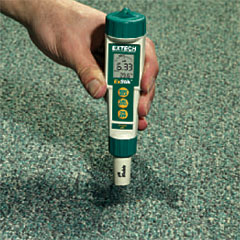home > carpet news > product knowledge > carpet cleaning
Product knowledge:
Carpet Cleaning
Reproduced with kind permission of Carpet and Flooring Review
Carpet cleaning has become a science. John Slesinski explains how the importance of knowing the acidity or alkalinity of the carpet fibre makes a pH meter a vital tool
In the ‘good old days,’ many carpet cleaning processes were more art than science. But as the years passed, science began to share equal billing. The process of carpet fibre analysis and cleaning, in both residential and commercial applications, has grown more scientific, relying more heavily on advanced methods and sophisticated cleaning agents to remove dirt, spills, and stains. Because of the complex fabrics being used in today’s floor coverings, as well as their highly developed stain resistant properties, it’s no wonder that the process of cleaning and restoring carpets has become less of an art and more of a science. The growth of the scientific side of this business has occurred for two reasons: |
|
|
At the heart of this push is the use of a pH analysis as a guide toward more efficient cleaning methods. pH is a unit of measure, ranging from 0 to 14, that indicates the degree of acidity or alkalinity of a solution. Solutions with a pH below 7 are considered acidic, solutions with a pH of exactly 7 are considered neutral and solutions with a pH higher than 7 are known as bases. With this explanation as a backdrop, it is easier to understand why the selection of cleaning or restorative chemicals is pH dependent. If the pH of the cleaning or restoration chemicals is not in the correct range, they can seriously or even irreparably damage the carpet. Consider: If the pH of a carpet fibre is 10 or 11, meaning that it is ‘basic’ – cleaning personnel will not want to select a highly alkaline or basic chemical to treat it. An acidic detergent should be used to neutralise the stain. What’s more, stain-resistant treatments on carpeting can be compromised or even removed if the pH is too high during and after cleaning, and wool carpet dyes could start to bleed if the pH rises over 7.0 during the cleaning process. With the value of pH measurement now firmly established, all that remains is the identification of an effective pH testing method. The market now offers a wide spectrum of sophisticated pH meters that are affordable, accurate and easy to use. In the early years it was either the bulb-type pH meter or pH paper that was employed, yet each had certain disadvantages, particularly for carpet. The bulb-type pH meter was ill-suited for a smooth carpet; it is only truly functional for carpet where the user can actually get the bulb surrounded by carpet fibre – as with shag, for instance. The shortcomings of pH paper are inaccuracy and potential carpet staining. Without question, the detection of a carpet’s pH, rather than the pH of the cleaning or restoration chemicals, has radically changed the way carpet cleaning is performed. What’s just as clear is that an accurate, portable and highly functional pH meter is critical to ensure that the science side of this process is well represented. |
||

 There is a wide range of pH meters on the market
There is a wide range of pH meters on the market